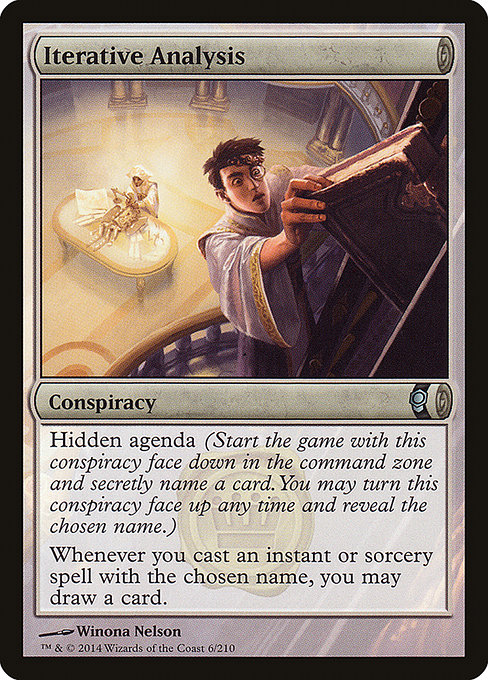
Image courtesy of Scryfall.com
Hidden Agendas and Un-Set Vibes: Iterative Analysis in Focus
Magic: The Gathering has always thrived on a delicate balance between polished strategy and cheeky surprise. The Un-sets—Unglued and Unhinged—paved the way for a different kind of magic: a meta-nod to the players themselves, a wink at the long hours we spend poring over ratios, synergies, and quirky interactions. The Conspiracy suite that arrived later kept that playful spirit alive, threading it into organized chaos you could actually draft and play in a tournament-friendly shell. At the heart of this conversation sits Iterative Analysis, a Conspiracy card that embodies the idea of a game within a game, a design puzzle that rewards players who savor the journey as much as the finish line. 🧙♂️🔥
Issued in the CNS “Conspiracy” set, Iterative Analysis is a rare little riddle: a colorless conspiracy with a hidden agenda. Its core mechanic is deceptively simple—start the game with this conspiracy face down in the command zone, quietly pick a card name, and later reveal that chosen name when you flip it (or turn it face up). From there, every time you cast an instant or sorcery with that exact name, you may draw a card. It’s a card that asks you to lean into anticipation, to build a deck not just around what you cast, but around what you’ve vowed to chase from the shadows. The flavor of it reads like a professor’s scribble in a grimy lab notebook: you plan, you reveal, and the table realizes the plan wasn’t the spell you cast—it was the brain behind your choices. 💎⚔️
Iterative Analysis is a 0-mana conundrum that scales with the players’ commitment to the chosen name. In a world where most draw effects come from active spells, this card flips the script: your payoff arrives the moment you cast a spell of the named kind, not when you draw from a generic source. The art by Winona Nelson gives a quiet nod to the era of drafting innovations, with a hint of the conspiratorial mindset that defines CNS. The set's watermark and frame carry that early 2010s curiosity—an era when designers experimented with new ways to tilt the odds without breaking the game’s backbone. And yes, in practical terms, Iterative Analysis is colorless and non-land; its true color is the mind of the pilot who dares to pick a name that actually shows up in their spells. 🎨
Design notes that feel ahead of their time
From a design perspective, the lack of a mana cost and zero color identity invite a thought experiment: what if a card’s strength emerges from the intentionality of a player’s choices rather than raw mana acceleration? Iterative Analysis embodies that question. The “Hidden agenda” keyword spotlights how players negotiate information asymmetry—you know your plan, your opponents do not, and the turn you reveal your chosen name can shift the entire tempo of the game. The Conspiracy set’s whole premise—secret plots, side drafts, and the thrill of a “what if” moment—bumps against the Un-set lineage in a harmonized way. It’s the kind of card that makes you grin, mutter, “Is this for real?” and then reach for a pen to sketch out a speculative decklist. 🧙♂️🎲
In terms of power economics, Iterative Analysis sits comfortably as an uncommon foil to the more punishing staples of its era. Its price tag on Scryfall—roughly $0.12 in USD for nonfoil and a modest foil premium—speaks to the playful but collectible nature of the Conspiracy line. It’s not a slam-dunk engine; it’s a strategic curiosity—a card that rewards long-term planning and the kind of deck-building that values theme and narrative as much as efficiency. For collectors, the foil versions offer a touch of shine that captures the era’s experimental charm—perfect for a display shelf or a policy debate about whether “conspiracy” is a separate wheel in MTG’s kaleidoscope of formats. 🔥💎
Beyond the number crunch, Iterative Analysis taps into the broader cultural pulse of Un-sets: the delight of turning a game on itself, the joy of seeing a plan unfold in tiny, satisfying steps. It’s less about brute force and more about storytelling through play, a hallmark of what many players love about casual Friday games and kitchen-table tournaments alike. The card’s hidden nature invites discussion: what name would you choose, and how would your deck thread the needle to cast those name-targeted spells again and again? That question alone makes Iterative Analysis a conversation piece at the table—one that bridges the nostalgia of Un-set mischief with the tactile thrill of Conspiracy’s shared planning. ⚔️🧩
For players who enjoy weaving in flavor with function, Iterative Analysis is a nice reminder that the best MTG cards aren’t always the loudest or the most efficient; they’re the ones that invite a story. They reward you for thinking not just about what you cast, but why you cast it—whose name you’ve chosen and what that choice says about your approach to the game’s hidden geometry. In this sense, the card mirrors the Un-set ideology: a nudge toward play that appreciates cleverness, camaraderie, and a little chaos, all tucked inside a well-constructed strategic frame. 🧙♂️🎨
As you contemplate a reprint dream or a vintage sleeve of CNS era cards, Iterative Analysis stands as a small but shining beacon of what makes the Un-Set and Conspiracy cross-pollination so enduring. It’s the perfect example of how a single line—“Whenever you cast an instant or sorcery spell with the chosen name, you may draw a card”—can spark hours of debate, design talks, and, occasionally, a few late-night memes about the “hidden agenda” of every spell you cast. And isn’t that a little magic we all chase in the end? 🧙♂️💫
Neon Card Holder MagSafe Phone Case for iPhone 13 / Galaxy S21-S22More from our network
- https://crypto-acolytes.xyz/blog/post/tracking-solana-wallet-growth-key-metrics-and-trends/
- https://crypto-acolytes.xyz/blog/post/iconic-arcade-fighting-games-that-defined-an-era/
- https://transparent-paper.shop/blog/post/go-viral-on-social-media-proven-tactics-for-fast-growth/
- https://blog.digital-vault.xyz/blog/post/white-instant-cross-set-connections-defiant-strikes-story/
- https://blog.digital-vault.xyz/blog/post/revoke-privileges-a-long-term-value-play-in-mtg-finance/